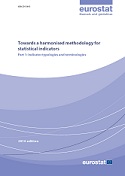Towards a harmonised methodology for statistical indicators — Part 1: Indicator typologies and terminologies - 2014 edition - Products Manuals and Guidelines
Towards a harmonised methodology for statistical indicators — Part 1: Indicator typologies and terminologies - 2014 edition
Indicators constitute an essential resource for policy-makers, business leaders and the general public. They assist us in making evidence-based decisions, allow comparisons to be made over time and between policies and programmes, countries and regions, social groups and industries, and contribute to increased transparency and accountability. Indicators also provide a very powerful way of communicating information. Indicators are used in many areas of social and environmental science, economics, business, and project management. We do not, however, have a common language for referring to them. The variety of adjectives which often accompany the word ‘indicator' provides a good illustration of this: headline, principal, key, core, main, primary, synthetic, composite, contextual, operational, complementary, explanatory, input, output, outcome and process — to name just a few. Navigating a route through this jungle of definitions is made much easier when we have some signposts marking the way. While recognising the importance of preserving the heterogeneity of uses and terminology specific to each domain, this paper aims to provide a point of reference for general questions about indicators and indicator sets: why do we use them? what can they measure? and how do they represent reality? This paper addresses these questions by referring to the existing literature on indicators and to concrete examples drawn from the experience of Eurostat and the European Commission as a whole, as well as other national and international institutions. With this paper, Eurostat wishes to initiate a dialogue in order to achieve more harmonisation and, as a result, will consider publishing a new version in the coming years.
Additional information
Product code: KS-GQ-14-011
ISBN 978-92-79-40322-4
ISSN 2315.0815
doi:10.2785/56118
ISBN 978-92-79-40322-4
ISSN 2315.0815
doi:10.2785/56118
Theme: General and regional statistics
Collection: Manuals and guidelines

